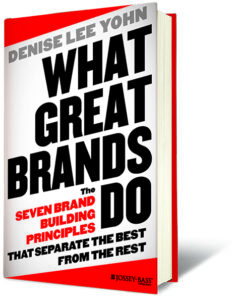What Makes a Brand Great
Denise Lee Yohn knows what makes a brand great. With twenty-five years of experience building some of the world’s greatest brands, she knows the strategies that work. Whether Burger King, Land Rover, Jack-In-the-Box, Spiegel, or Sony Electronics, Denise has knows the principles that make a great brand. Her book on branding is a must read: What Great Brands Do: The Seven Brand-Building Principles that Separate the Best from the Rest.
If you think branding is a logo or an advertising campaign, think again. You may think you don’t “do” branding, but then you will miss learning some incredibly important business ideas—because corporate branding means more, and all of us have a personal brand.
Denise, when most people think of branding, they think of a television commercial, an internet ad or a new logo. It’s ironic to me that branding itself is not branded properly. Your book completely redefines what great branding is. Why do most people have the wrong impression about branding?
Branding actually refers to the practice of putting a symbol on a thing – ranchers used to brand their cattle with a unique mark to indicate their ownership. The practice was then adopted by companies selling products. They developed logos to put on their products to distinguish them and to signal which companies made them. Over time these symbols became cues of product quality and meaning – people would assume a product from a particular company had a level of quality consistent with the company’s past or other products, and they would attribute some meaning to it when they associated the logo with it. Marketers worked hard to develop compelling logos and strong positive associations with them. 
So technically the understanding of branding as a business practice is still correct, but it’s clear that the value of branding has diminished. It’s no longer enough to develop a creative logo or to launch clever marketing campaigns to express what your brand stands for. Companies must execute on their brand identities too. Today’s savvy customers can see through a branding veneer, so a company must translate its brand vision into customer reality.
Let’s touch on a few of your branding principles to give a flavor for your unique approach to brand-building. The first is great brands start inside—with culture. Why is organizational culture the starting point?
Culture is the necessary first step when you want to define or re-define your brand because culture is what ensures your employees understand and embrace what your brand stands for and understand their roles in interpreting and reinforcing your brand. So great brands rally their people around common cultural values and use their brands to focus, align, and optimize the inner workings of their organizations.
7 Branding Principles of the Best Brands
1: Great brands start inside.
2: Great brands avoid selling products.
3: Great brands ignore trends.
4: Great brands don’t chase customers.
5: Great brands sweat the small stuff.
6: Great brands commit and stay committed.
7: Great brands never have to “give back.”
Avoid Selling Products
Another principle is great brands avoid selling products. That seemed counterintuitive until I read your book. Would you share one example of this principle in action?
I just learned of the way the brand managers behind the Powerade brand were able to give Gatorade, the sports drink category leader, a run for its money. Although Powerade’s formulation contains 33% more carbohydrates than Gatorade, the marketing for the brand made no mention of this product claim. Instead, the company successfully appealed to high school students by positioning Powerade as the must-have “equipment” for athletic performance. They connected with teenage males through the key emotional drivers of teen sports — demonstrating masculinity, displaying confidence, and achieving success. They knew, like other great brands know, that attracting people through emotion is far more effective than pushing product features.

What about the principle, “Great brands sweat the small stuff.” You go so far as to say, “Make the small stuff your business.” Give us an example of this at work.
Have you ever noticed how when you thank an employee at Chick-fil-A, he or she responds, “My pleasure”? Or how the chain’s restrooms are well-maintained with turned down corners of the toilet paper? Or how the employees there offer to carry your tray for you and refill your drink? None of these elements of the Chick-fil-A customer experience just happens. They’re the result of a specific, deliberate service strategy that the company has designed and implemented. The folks at Chick-fil-A ensure that their brand values of service and giving are expressed in the finest details of their execution. That’s what building your brand by sweating the small stuff looks like.
Brand As Business
There’s an eighth principle that is fundamental to every action a company takes—and that is, “Great brands do brand as business.” What does this mean?
“Brand as business” is the management approach that employs your brand as the central organizing and operating idea of your business. It involves using your brand to drive the culture, core operations, and customer experiences of your organization. And it’s comprised of the brand-building principles described in my book. In fact, although the seven principles are presented in separate chapters in my book, they are not individual, discretionary philosophies. They are part of an integrated, indivisible holistic approach to managing and growing a business – the brand-as-business management approach. Brand as business produces strong, integral, valuable brands. Brand as business is what great brands do.
What Great Brands Do: The Seven Brand-Building Principles that Separate the Best from the Rest



